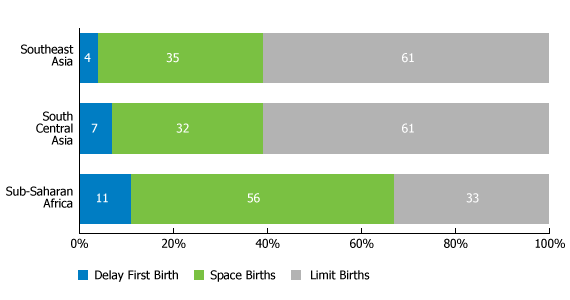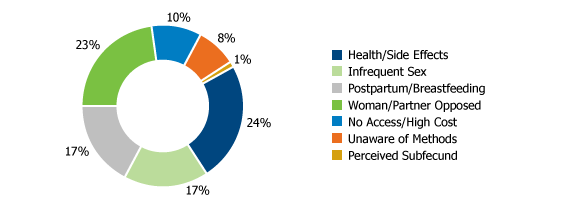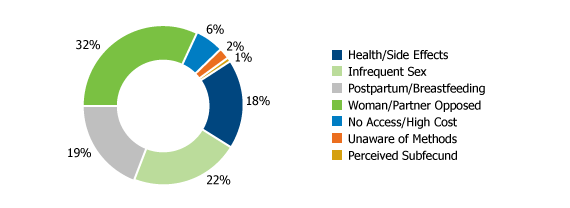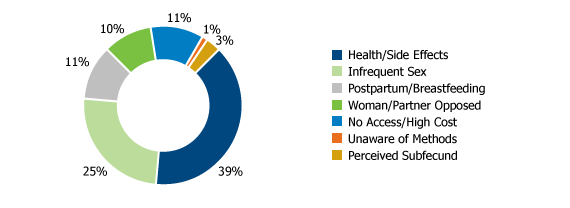
Unmet Need for Contraception: Fact Sheet
What Is Unmet Need?
- Women who have an unmet need for contraception are broadly defined as those who want to delay or stop childbearing but are not using contraception. Put another way, these women are potential users of contraception. This concept of unmet need has influenced the development of family planning programs for decades, and several years ago unmet need was added as an indicator to Millennium Development Goal 5, improving maternal health.
- In developing countries about half of sexually active women of reproductive age, or 818 million women, want to avoid pregnancy, meaning that they do not want to become pregnant for at least two years or want to stop childbearing altogether. About 17 percent of those women, or 140 million, are not using any method of family planning, while 9 percent, or 75 million, are using less-effective traditional methods. Together, these 215 million women are said to have an unmet need for modern contraception.1
- Women have various reasons for not wanting to become pregnant. Some want to delay their first birth; they want to have a child at some point in their lives, but not yet. Some women already have one or more children and want another child, but they want to wait at least a few more years because they prefer to space their births. Other women either do not want to have any children or have had all the children they want; researchers call this a need to limit births. This is important because certain contraceptive methods may better suit the needs of women who want to delay or space births, while others are better for women who want to stop childbearing altogether.
Figure 1
Among Women With Unmet Need for Modern Contraception, the Percentage of Those Wishing to Limit Births is Nearly Twice as High in Southeast and South Central Asia as Compared With Those in Sub-Saharan Africa.

Source: Jacqueline E. Darroch, Guilda Sedgh, and Haley Ball, Contraceptive Technologies: Responding to Women’s Needs (New York: Guttmacher Institute, 2011).
Why Is Unmet Need Important?
- Women who want to avoid pregnancy but are not using an effective method of contraception account for a large majority (82 percent) of unintended pregnancies.2> Abortion is a major consequence of unintended pregnancy, and in many developing countries that restrict abortion, terminations often are performed under unsafe conditions and result in women dying or suffering serious injuries. Unintended pregnancies can also lead to delayed or no antenatal care, which can pose health risks to both mothers and infants.
- The Guttmacher Institute estimated in a 2009 report that if all women who wanted to avoid pregnancy were using modern contraceptives, the number of unintended pregnancies in developing countries would fall from 75 million to 22 million annually.3. This would translate to 22 million fewer unplanned births, 15 million fewer unsafe abortions, and 90,000 fewer maternal deaths.
What Causes Unmet Need?
- Unmet need is often portrayed as a problem of access, leaving the perception that women do not use contraceptives because they cannot find or afford them or they have to travel too far to get them. But while access is an issue, women have many other reasons for not using family planning, including personal, cultural, or religious objections, fear of side effects, health concerns, and lack of knowledge. For this reason, just making contraceptives available does not ensure that women will use them.
- A World Bank report notes that unmet need can be a sign of situations that may be occurring within a country. In countries where many women prefer large families and do not want to space or limit births, unmet need as well as contraceptive use will be low. In other countries that are in transition to smaller families, unmet need will probably increase until information, supplies, and services meet the increasing demand for contraception. Therefore, high levels of unmet need are not necessarily due to the failure of a family planning program, but may reflect growing demand for contraception.4>
Why Do Women Who Want to Avoid Pregnancy Not Use Family Planning?
The Demographic and Health Surveys offer some hints on why women do not use contraception, and the reasons differ among countries and regions within countries. The main reasons include:
- Concerns about health risks or side effects.
- Opposition to use, either by the woman or her partner, for personal or religious reasons.
- Perception that they would not get pregnant because they had sex infrequently, had postpartum amenorrhea, or were breastfeeding.
- Lack of knowledge about methods of contraception or where they could get them.
- Inability to obtain or afford contraceptives.
In sub-Saharan Africa, the two most commonly cited reasons were health risks/side effects and opposition by the woman and/or partner. In South Central Asia, opposition by the woman and/or partner was the main reason, followed by infrequent sex. In Southeast Asia, health concerns and side effects were cited most, followed by infrequent sex.5
Figure 2
Sub-Saharan Africa: Reasons for Nonuse Among Women With Unmet Need for Modern Contraception

Source: Jacqueline E. Darroch, Guilda Sedgh, and Haley Ball, Contraceptive Technologies: Responding to Women’s Needs (New York: Guttmacher Institute, 2011).
Figure 3
South Central Asia: Reasons for Nonuse Among Women With Unmet Need for Modern Contraception

Source: Jacqueline E. Darroch, Guilda Sedgh, and Haley Ball, Contraceptive Technologies: Responding to Women’s Needs (New York: Guttmacher Institute, 2011).
Figure 4
Southeast Asia: Reasons for Nonuse Among Women With Unmet Need for Modern Contraception

Source: Jacqueline E. Darroch, Guilda Sedgh, and Haley Ball, Contraceptive Technologies: Responding to Women’s Needs (New York: Guttmacher Institute, 2011).
Other resources on unmet need:
Guttmacher Institute: Contraceptive Technologies: Responding to Women’s Needs (PDF: 2MB)
Guttmacher Institute: Facts on Satisfying the Need for Contraception in Developing Countries
The World Bank: Unmet Need for Contraception
Population Reference Bureau:Unmet Need for Family Planning: Recent Trends and their Implications for Programs
References
- Jacqueline E. Darroch, Guilda Sedgh, and Haley Ball, Contraceptive Technologies: Responding to Women’s Needs (New York: Guttmacher Institute, 2011).
- Darroch, Sedgh, and Ball, Contraceptive Techologies.
- Susheela Singh et al., Adding it Up: The Costs and Benefits of Investing in Family Planning and Maternal and Newborn Health (New York: Guttmacher Institute and UNFPA, 2009).
- The World Bank, Unmet Need for Contraception (Washington, DC: The World Bank, 2010).
- Darroch, Sedgh, and Ball, Contraceptive Technologies.
